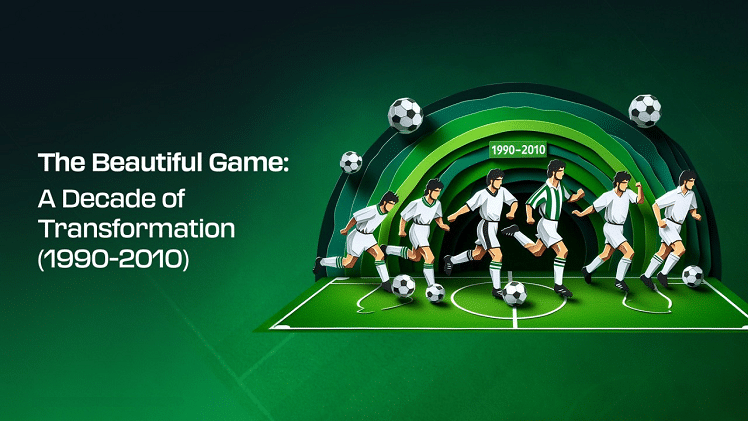Transcending the Beautiful Game: The Future of Football With VAR, and Wearable Devices at Barcelona

Football, or soccer as it is known in some parts of the world, is a sport that has very deep roots. Yet, like every other major sport, it has changed for the better or worse really, with the emergence of technology. The influence of technology has changed the entirety of the game – how it is played, how it is officiated and how the fans experience it. While football has always been about adherence to the fundamentals of the game, new technologies have revolutionized the industry and have offered a higher degree of accuracy, equity, and information, much like how pism-docs.org uses technology to enhance the gaming experience.
In this article, we will discuss the evolution in the technology of football with special consideration going to three areas of innovation: VAR (Video Assistant Refereeing), intelligent footballs, and bodywear technologies. Football will forever be changed for the better due to these technologies which assist players in decision-making, performance analysis, and competitive strategy, thereby improving the game’s future.
Exploring VAR: The Video Assistant Referee in Football’s Beautiful Game
It is quite clear that the Video Assistant Referee (VAR) is one of the most, if not the most, controversial changes brought about by technology in the contemporary game of football. The concept was first used in an official capacity at the 2018 FIFA World Cup in Russia. Because VAR gives match officials the ability to examine video, it aims to maintain the fairness of crucial match moments as much as possible.
How VAR Works
VAR is concerned with looking at the following four types of decisions:
- Goals and any offense that led to the goal being scored
- The decision of awarding a penalty
- Dismissal by red card
- A case of mistaken identity in relation to the award of cards
The referee in charge of the game relies on a host of relevant officials situated in a control room who oversee the game from different camera angles. In situations where a potential error is found, the referee can either take the advice of the var officials or review the footage themselves on established pitch side monitors.
The Future of VAR
It is correct to point however that while VAR has dramatically cut down the number of obvious mistakes committed by referees, this has also led to controversy mainly due to time delays and further, the subjective interpretation of incidents. However, steps are being taken to address these issues whereby a quick decision is made on contentious calls involving handballs and offside rulings. It is possible in the future that AI could take the role of the referee as well, assisting in the making of VAR decisions to create quick and more objective call resolution.
Separate notes reveal that AI-assisted offside technology is already being deployed by FIFA, and this could further enhance the efficiency and accuracy of calls to eliminate the necessity for many drawn out video replays. Further to that, the possibility of immediate feedback being introduced to fans in the stadium about the VAR decision, during the decision making process as well, may provide clarity and facilitate an understanding of the decisions.
Smart Balls: Enhancing Accuracy and Data Collection in Football’s Beautiful Game
The evolution of football itself has not been left out. Smart balls that are still in the developing stage are anticipated to revolutionize game play as they allow real time updates about the ball’s position or interactions with players on the field.
How Smart Balls Work
A smart football comes with tracking sensors which can record speed, spin and field coordinates of a specific ball. The data is transmitted to a central system constantly which means referees and coaches can analyze ball motion and other features in ways that were previously impossible.
An example of this technology in application occurred in the recent past, 2022 soccer World where a smart ball was able to help in making offside decisions and incorporating goal line technology. The sensors embedded in the ball were able to establish whether the ball crossed the line or whether a player was offside during a play with accuracy of milliseconds.
The Future of Smart Balls
The smart balls would not only change the game officiating but the way the game would be trained and strategies developed too. There would be use of smart balls to study passing correctness, shot angles, the transference effect of the ball in windy areas and other conditions. This would enhance comprehension of game emotions and the player’s actions.
The same intelligent balls in the not-too-distant future, could also be connected directly to the players’ wearables, thus achieving full insulation of data of the balls and the players. This will allow for an even more profound level of detail in analysis of more aspects of the dynamics of the game and also give the coaches a fresh perspective on how their teams perform dynamically, in real time.
Wearable Devices: Tracking Player Performance on Barcelona Pitch
It is already evident that the training and the in-game performance of football players is becoming substantially easier with the help of various sorts of wearables. Gadgets such as heart rate monitors, accelerometers, and GPS trackers allow coaches and medical personnel to assess training loads, estimate a player’s fitness, fatigue, and expression of injuries more accurately.
Classification of wearable devices
In football, the wearables can be classified into the following:
- GPS trackers: Applied during training and matches to quantify and monitor a player’s position, velocity, and distance traveled
- Heart rate monitors: Allow a player to know the conditions of the heart muscle, such as how much effort has been used.
- Accelerometers: Determine the rate of change of velocity, impact, instantaneous velocity proportional to the change of direction. It helps in the evaluation of the impact agility and explosiveness
- Smart clothing: These include jerseys and shorts fitted with sensors designed to monitor muscle activity, skin temperature and hydration level.
Such information can be uploaded and accessed at the same time by coaches who can effectively implement changes to the tacticians or even substitutes with ease, all depending on the physical cond of respective players.
The Future of Wearables in Football
The role of these devices in football, however, will only increase. The combination of machine learning algorithms and artificial intelligence may enable head coaches to better assess injury risk and design personalized training programs for each individual player.
Digital wearables might also benefit football fans. In the future, broadcasts may allow viewers to track players’ statistics, such as how fast they sprinted or how far they ran, while further increasing fans’ comprehension of the game’s mechanics. Using this information, fans could also enthusiastically engage in AR interactions at live events, where they could
The Role of AI in Shaping Football’s Technological Future – Explore Topics
Many of them are based on athletes’ devices; the development of football technologies is possible thanks to artificial intelligence. Whether it be improving VAR calls or processing wearable information, athletes or trainers are increasingly relying on AI to support their decisions regarding performance, both on and off the field.
AI cameras have begun being utilized at lower league training camps to follow players autonomously, eliminating the need for human operators. One day, it is entirely possible that AI will be able to supply systematic recommendations to coaches during a game.
AI in Player Recruitment
Additionally, AI is revolutionizing the way teams search for and acquire new players. Advanced data analytics platforms have evolved to such an advanced stage that they are able to analyze a number of hundreds in terms of a player’s previous performances and forecast his possible impact on future performance with the ultimate goal being to ‘bring him on board the team’. This has contributed towards better investment activities in terms of player acquisitions by clubs.
Conclusion
There is no doubt that as technology develops, football is on the verge of moving to the next level in terms of accuracy, performance, and fan involvement. Change is already coming to the game with the introduction of VAR, smart balls, wearable technology, and other innovations making football more data-driven and improving the standard of gameplay. With the deployment of AI technology being a core in the creation of these innovations, the game of football will provide a more strategic, tactical, and enjoyable competitive edge than ever before.
All those who partake in football, be it as a player, coach, or fan, the outlook for the industry is brighter than ever now and promises more subtly and beautifully designed visuals that will captivate everyone. Whether it’s the dribble of a player, the kick of a ball, or the click of a teammate’s pass, football continues to be at the centre of global sports. As we move forward, considerations like privacy policy and cookie policy will also play a role in how data is managed. The rivalry between teams will remain fierce, but the game will continue to unite and inspire, just as it has since 2021.



